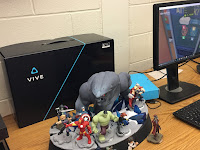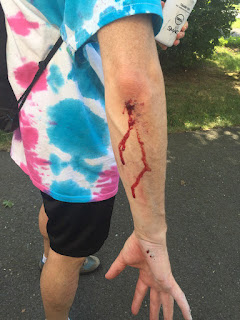For years, my vision for the ultimate learning space was taking form. I teach Game Design and Development at William Annin Middle School in Basking Ridge, NJ. My dream was to create a studio feel for my learning space where students could pursue different avenues for learning and have a wide variety of resources available for them.
When I wrote the curriculum for the course I was able to build out the computer lab and include an Xbox 360 so students could create content for the Xbox using Visual C# and XNA Studio. This was a start, but I had bigger plans.
My vision included large LCD wall-mounted TVs, cozy sitting areas, multiple gaming consoles, Virtual Reality headsets, tabletop games, and other resources to provide students with a wide variety of opportunities to take learning into their own hands.
I was not sure how I would fund this venture, but that didn't stop me from dreaming BIG!
In March, 2014 I discovered Donor's Choose. I created a project called Empowering Learners in the Makers Age and asked for funds to purchase items including The XBOXOne, MakeyMakey, the OUYA Gaming Console, Raspberry Pi, Disney Infinity and several books to support students in learning to use these products. The project was fully funded and provided a great starting point in terms of moving toward the vision.
When I wrote the curriculum for the course I was able to build out the computer lab and include an Xbox 360 so students could create content for the Xbox using Visual C# and XNA Studio. This was a start, but I had bigger plans.
My vision included large LCD wall-mounted TVs, cozy sitting areas, multiple gaming consoles, Virtual Reality headsets, tabletop games, and other resources to provide students with a wide variety of opportunities to take learning into their own hands.
I was not sure how I would fund this venture, but that didn't stop me from dreaming BIG!
In March, 2014 I discovered Donor's Choose. I created a project called Empowering Learners in the Makers Age and asked for funds to purchase items including The XBOXOne, MakeyMakey, the OUYA Gaming Console, Raspberry Pi, Disney Infinity and several books to support students in learning to use these products. The project was fully funded and provided a great starting point in terms of moving toward the vision.
 |
|||
|
 |
For the next phase of my vision, I wanted to bring non-digital games into the classroom so students could analyze and deconstruct the game mechanics. While most of the games my students create are digital, I believe it is important for them to experience and consider creating non-digital games as well. With choice at the center of the class, students get to choose what type of game they create. From a pedagogical standpoint, my class is about the iterative design process so the type of game is left up to the students.
We submitted another donors choose project, Game Design, Analysis and Deconstruction of Non-Digital Games. This project was submitted in October, 2014 and funded in 3 days!
 |
 |
 |
Making progress!
We had acquired some great resources and the kids were embracing the passion driven / choice based learning environment.
Our PTO has a call twice a year for 'wish list' grants to enhance the learning in our classrooms. In February, 2015 I put in a wish list for 3 large screen LCD TVs, a sound bar, and the hardware to connect the TVs throughout the room so that we could view content and present on all three TVs. This would make for a great space for learning as well as student content creation when it came to creating and testing games on the consoles. It would also provide a great training space for district wide Professional Development. I conduct a lot of PD for our staff and this would benefit our staff college program as well as classroom instruction. Above all, it would make for a super cool learning space that helped my vision to become a reality.
The PTO was gracious enough to fund the project and now we were REALLY moving forward!
 |
 |
 |
We continued to move forward with two another Donors Choose projects, Empowering Learners in the Maker Age: Take 2 and Empowering Learners in the Maker Age: Take 3. These projects brought additional resources to our class including The Playstation 4 with Little Big Planet 3 so students could create games for the PS4, the WiiU and Super Mario Maker so students could create their own Super Mario Brothers worlds, Little Bits so students could work with Minecraft and Littlebits to merge the physical and virutal worlds with the Bitcraft Mod and much more.
You can read about how my students were using many of these tools through blog posts dedicated to our 20% time projects:
- 20% Tuesday!
- 20% Tuesday: Week 2 Reflection
- 20% Tuesday: Week 3 Reflection
- 20% Tuesday: Week 4 Reflection
- 20% Tuesday: Week 5 Reflection
- 20% Tuesday: Week 7 Reflection
- Guest Blog Post: Student Reflections on 20% Time
The TVs have also provided us with great opportunities to connect with other classrooms and Industry Professionals via Skype. For the past two years we have participated actively in the Global Skypeathon. We are excited to meet with some amazing people this year!
Next stop... Virtual Reality!
foundry10, an educational foundation focusing on nontraditional approaches to learning began conducting research on the use of Virtual Reality in the classroom in Fall, 2015. My Game Design and Development program was selected as one of the pilot programs to participate. As such, we received the Oculus Rift SDK2 for students to use to explore VR content and create content to be experienced in Virtual Reality. During our first year, members from the foundry10 team visited us from Seattle to demo the HTC Vive. We were able to use the Vive for two weeks. To say the Vive was a hit would be a gross understatement. In addition to my students using the tech, they became the experts who could demo it with others. We maintained an open door policy in the classroom allowing others to come in and experience VR. It was an empowering experience for my students and certainly provided others with a sense of the potential of Virtual Reality in education.
Now we are participating in year 2 of the research and this year we were provided with an HTC Vive of our own. The students are exploring content, creating content within VR, and reviewing VR software to contribute to the greater community.
Now we are participating in year 2 of the research and this year we were provided with an HTC Vive of our own. The students are exploring content, creating content within VR, and reviewing VR software to contribute to the greater community.
The final piece to complete the vision for our learning space was comfortable seating around the TV areas. This would help to truly create an inviting and inspiring space for my students. Once again, I went to our school PTO with a wish list grant. I explored a number of options for seating with my students. Some were prohibitively expensive. Based on suggestions from other educators, Marianne Malmstrom (@knowclue) and Peggy Sheehy (@peggysheehy) who have created truly student centered learning spaces we looked at yogibo bean bag furniture. The goal was to create two spaces, one for each side of the room in front of the TVs. Up to this point, kids were sitting on regular classroom chairs or standing to use the gaming consoles on the TVs. I couldn't wait to create a true living room inspired space for use with the TVs for building games, table top gaming, skyping with other classes and professionals, collaboration, and relaxing while reading or watching relevant videos. In addition, the space is often used by other classes and the after care program. This would create a space that the students could truly love being in. After all, school should be inviting and inspire learning. I believe that my learning space does just that. As Beth Houf would say, "We want to create a school where students, staff and parents are beating down the doors to get in...not out"
Here are some pics that show the final result and the learning space that my students and I absolutely LOVE!
Here are some pics that show the final result and the learning space that my students and I absolutely LOVE!
 |
 |
 |
 |
 |
 |
 |
 |
 |















